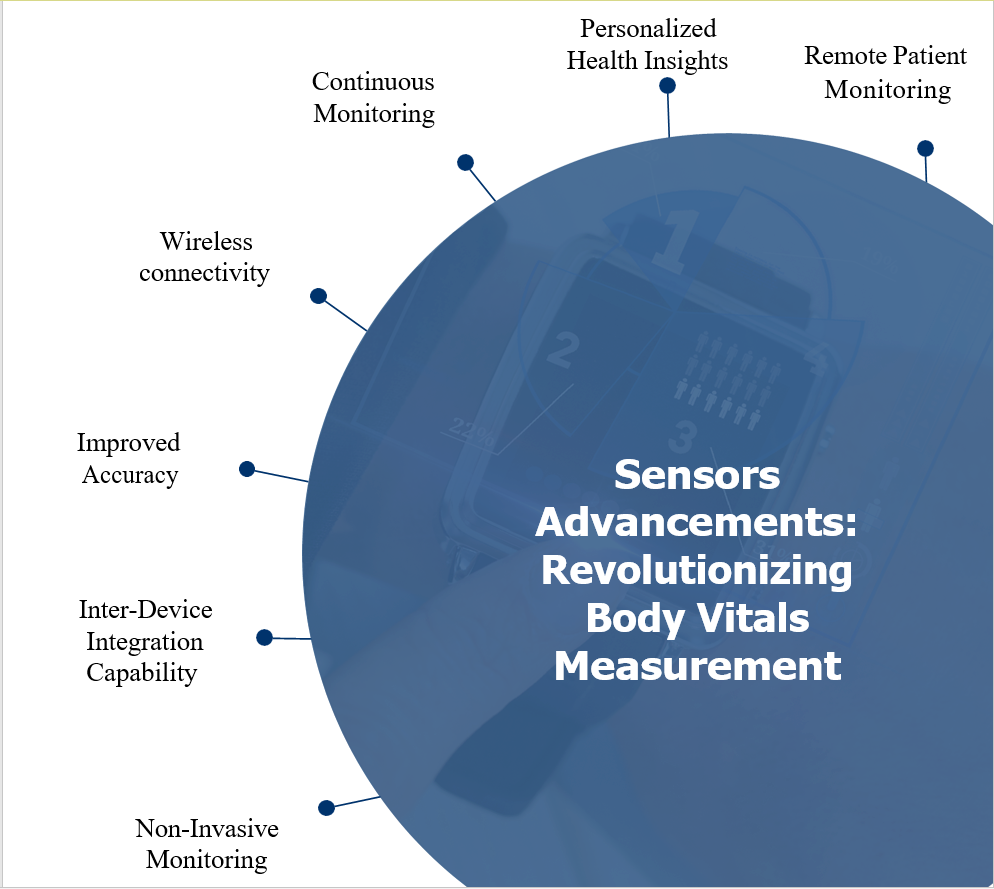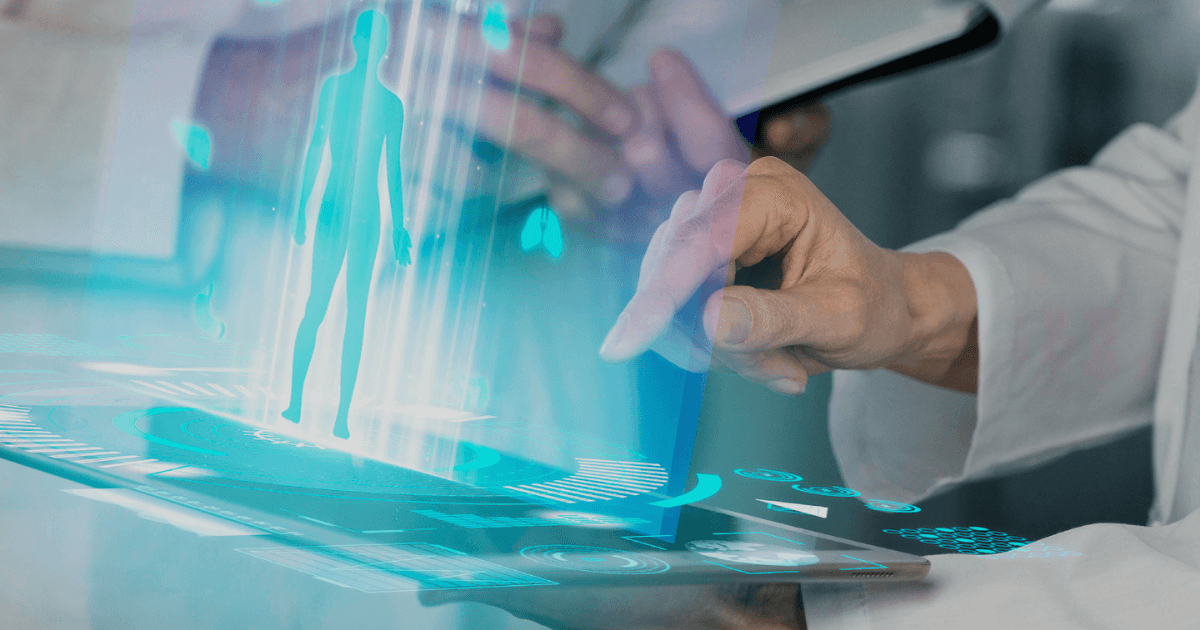The continuous development of sensor technologies has revolutionized the way we monitor and manage our health, leading to more accurate and efficient measurement of body vitals. Sensor technologies have played a significant role in advancing healthcare and improving patient outcomes. Sensors are becoming increasingly sophisticated and are being developed for a wide range of applications, including monitoring body vitals. As wearable devices and remote monitoring become increasingly popular, the demand for accurate, reliable, and non-invasive sensors to measure body vitals has grown. In recent years, we have seen substantial improvements in sensor technologies that have the potential to revolutionize how we monitor our health. These advancements have facilitated early detection of potential health issues, improved disease management, and enhanced overall patient care. This article will explore the latest innovations in sensor technologies that are set to improve the monitoring of body vitals and reshape the future of healthcare.
Enhanced Accuracy and Precision: The Evolution of Vital Sign Measurement
Advancements in sensor technologies are focusing on improving the accuracy and precision of vital sign measurement. By developing more sensitive and reliable sensors, healthcare providers can obtain better quality data, allowing for early detection of potential health issues and improved patient outcomes. Innovations in this area include the integration of artificial intelligence (AI) and machine learning algorithms to refine sensor readings and reduce the impact of external factors, such as motion artifacts and environmental noise.
For example, Masimo’s SET® pulse oximetry technology has significantly improved the accuracy of measuring blood oxygen saturation (SpO2) and pulse rate, even in challenging conditions such as low perfusion and patient movement (Masimo, 2021). This allows healthcare professionals to make better-informed decisions regarding patient care.
Wearable Sensor Technologies: Revolutionizing Continuous Monitoring
Wearable sensor technologies are rapidly evolving to provide continuous monitoring of body vitals in real-time, with minimal disruption to the user’s daily activities. Examples of these improvements include the development of flexible and stretchable sensors that can be embedded in textiles or attached directly to the skin, as well as the miniaturization of electronic components for sleeker and more comfortable wearable devices.
Wearable sensor technologies like the Ultrahuman M1 have the potential to revolutionize healthcare by providing more detailed and accurate data for continuous monitoring of health parameters. These are helpful in providing real-time feedback on key indicators of health and enabling individuals to take a more proactive approach to their health. Real-time glucose monitoring, sleep tracking, stress monitoring, and fasting tracking are just a few of the features of the UltraHuman M1, making it a powerful tool for improving health outcomes and achieving wellness goals. This can lead to earlier detection of health issues and more proactive management of chronic conditions.
Implantable Sensors: Advancements in Implantable Sensors for Real-Time Monitoring
Implantable sensors have made significant strides in recent years, providing real-time monitoring of vital physiological parameters. These devices are designed to be biocompatible, ensuring minimal risk of rejection or infection. They offer continuous, accurate monitoring of various body vitals, such as blood glucose, blood pressure, and cardiac activity, enabling healthcare professionals to make timely and informed decisions.
For example, the Eversense Continuous Glucose Monitoring (CGM) system by Senseonics is an implantable sensor that measures glucose levels in people with diabetes. The sensor is inserted under the skin and provides real-time data for up to 90 days, enabling better management of glucose levels and reducing the risk of complications. Another example is Medtronic’s Micra™ leadless pacemaker, which is implanted directly into the heart to regulate heartbeats, eliminating the need for wires, and minimizing the risk of infection.
Non-Invasive Sensors: Overcoming Limitations of Invasive Techniques for Measuring Body Vitals
Non-invasive sensor technologies have evolved to overcome the limitations associated with invasive techniques for measuring body vitals. These advancements have led to the development of more comfortable, user-friendly devices that minimize the risks and discomforts linked to invasive procedures.
For instance, optical sensors have been developed to measure blood oxygen saturation (SpO2) noninvasively. The pulse oximeter, a device that clips onto a fingertip or earlobe, uses light absorption to calculate SpO2 levels without the need for drawing blood. Similarly, advanced wearable devices like smartwatches and fitness trackers have incorporated optical sensors to measure heart rate, providing real-time data on the user’s heart activity.
Enhanced Connectivity: Real-Time Data Transfer for Informed Decision Making
Advanced connectivity options, such as Bluetooth, Wi-Fi, and cellular networks, have revolutionized the way sensor data is transmitted and shared. Enhanced connectivity enables real-time data transfer from sensors to smartphones, tablets, or healthcare providers’ systems, allowing for immediate analysis and response.
For example, the Dexcom G6 CGM system wirelessly transmits glucose data to a compatible smart device, providing real-time glucose readings and trend information. This connectivity allows users and healthcare providers to make informed decisions about diabetes management. Similarly, wearable devices like the Apple Watch can transmit heart rate data to a connected iPhone, enabling users to track their heart health and share information with healthcare professionals if needed.
These advancements in sensor technologies have not only improved the accuracy and comfort of measuring body vitals but have also allowed for more informed decision-making by users and healthcare providers. As these technologies continue to develop, they hold great promise in shaping the future of personalized healthcare and enhancing overall health and well-being.
Implantable Sensors: Harnessing AI and Machine Learning for Automated Data Analysis and Interpretation
The rapid advancements in implantable sensor technologies have opened up new possibilities for healthcare monitoring and diagnostics. One of the key developments in this field is the integration of artificial intelligence (AI) and machine learning (ML) algorithms for automated data analysis and interpretation. By leveraging AI and ML, these implantable sensors can provide real-time insights into a patient’s health, allowing healthcare providers to make informed decisions and offer personalized treatment.
AI-driven algorithms can process vast amounts of data generated by implantable sensors, identifying patterns and anomalies that may be indicative of health issues. This enables early detection of potential problems and timely intervention, reducing the risk of complications and improving patient outcomes. Furthermore, AI and ML capabilities allow for continuous improvement and adaptation of the algorithms as more data becomes available, ensuring that the analysis remains accurate and relevant over time.
For example, the Eversense Continuous Glucose Monitoring (CGM) system by Senseonics is an implantable sensor that continuously measures glucose levels in people with diabetes. The system utilizes AI algorithms to process and analyze the collected data, providing users with real-time glucose trend information and alerts for potential hypoglycemia or hyperglycemia events. This advanced data analysis and interpretation enable users and healthcare professionals to make informed decisions regarding diabetes management and treatment.
User-Centric Design: The Intersection of Interactivity and Interoperability
A critical aspect of implantable sensor technologies is their user-centric design, which focuses on providing seamless interactivity and interoperability. This approach ensures that the sensors can easily communicate with other devices and healthcare systems, enabling healthcare providers to access and share vital data with minimal effort.
The user-centric design also considers the patient’s comfort and ease of use. By developing sensors that are biocompatible, minimally invasive, and comfortable to wear, patients are more likely to embrace and utilize these technologies for continuous health monitoring. Furthermore, user-friendly interfaces and applications allow patients and healthcare providers to access and interpret data effortlessly, promoting proactive health management.
For instance, the Oura Ring is a wearable health tracker that measures various body vitals such as heart rate, sleep quality, and body temperature. It features a sleek and unobtrusive design, along with a user-friendly smartphone app. The app provides users with easy access to their health data, visualizations, and personalized insights. Moreover, the Oura Ring can be integrated with various other health and fitness apps, ensuring seamless interoperability and a comprehensive view of the user’s health.
Power Management Innovations: Extending Battery Life for Uninterrupted Monitoring
One of the challenges faced by implantable sensor technologies is the need for efficient power management to ensure uninterrupted monitoring. Prolonging battery life and reducing the need for frequent recharging or replacement is essential for maintaining continuous health monitoring and minimizing disruptions to the patient’s daily life.
Innovations in power management have led to the development of energy-efficient sensors that consume less power while maintaining accurate data collection. Additionally, researchers are exploring the potential of energy harvesting technologies, such as using body heat or movement to generate power, to extend battery life further. These advances in power management play a crucial role in ensuring that implantable sensors can provide continuous, reliable monitoring for improved patient care and health management.
The Garmin Vivosmart 4 is one such sensor that is a slim and stylish fitness tracker that measures various body vitals such as heart rate, stress levels, and sleep quality. Because of its advanced power management system and energy-efficient sensors, the Vivosmart 4 boasts a battery life of up to 7 days, allowing users to track their vitals continuously without the need for frequent charging.

Challenges and Limitations: Addressing the Challenges and Limitations of Sensor Technologies for Measuring Body Vitals
- Accuracy and Precision: Ensuring that sensor technologies provide accurate and precise measurements of body vitals is crucial for reliable health monitoring. This involves continuous research and development, testing, and validation of sensors to minimize errors and maintain high standards of data quality.
- Data Security and Privacy: As the volume of sensitive health data collected by sensors increases, so does the need to protect this information from unauthorized access and breaches. Implementing robust encryption, secure data storage, and stringent access controls is essential to safeguard patient privacy and ensure compliance with data protection regulations.
- Skin Sensitivity and Biocompatibility: For wearable or implantable sensors, it is vital to consider skin sensitivity and biocompatibility issues. Materials used in sensor construction must be hypoallergenic, non-toxic, and biocompatible to minimize the risk of skin irritation or adverse reactions.
- Environmental Interference: Sensors can be susceptible to interference from external factors such as temperature, humidity, or electromagnetic fields. Developing robust sensor designs that can withstand and compensate for these environmental influences is crucial for maintaining accurate and consistent measurements.
- Sensor Calibration and Maintenance: Over time, sensors may require calibration and maintenance to ensure their continued accuracy and functionality. Developing user-friendly calibration methods and designing sensors with minimal maintenance requirements can help overcome this challenge.
- Integration and Interoperability: Integrating sensor technologies with other devices and healthcare systems is critical for seamless data exchange and communication. Ensuring that sensors are compatible with various platforms and follow standardized communication protocols can facilitate interoperability and improve the overall user experience.
- Cost and Accessibility: The cost of sensor technologies can be a barrier to their widespread adoption and use, particularly in low-resource settings. Developing affordable sensor solutions without compromising quality and functionality can help make these technologies more accessible to a broader population.
- User Acceptance and Compliance: For sensor technologies to be effective, users must be willing to adopt and consistently use them. Addressing concerns about comfort, ease of use, and perceived benefits can help improve user acceptance and compliance with sensor-based health monitoring.
- Regulatory and Ethical Considerations: As sensor technologies evolve and become more sophisticated, they may raise regulatory and ethical concerns. Navigating the complex landscape of medical device regulations and addressing potential ethical dilemmas associated with data collection and use is essential for the successful deployment of these technologies in healthcare.

Challenges in Sensor Technology:
- Regulatory and Ethical Considerations
- Cybersecurity risks
- Data privacy concerns
- Potential for misdiagnosis
- Risk of sensor failure
- User compliance challenges
- Lack of standardization
- Accuracy and reliability limitations
- Bias and data interpretation
Conclusion: The Transformative Impact of Sensor Technology Advancements on Health Monitoring and Outcomes
In conclusion, advancements in sensor technology have revolutionized the way we monitor and manage our health. Wearable, implantable, and non-invasive sensors provide continuous monitoring of body vitals, allowing for more accurate diagnoses, better-informed decisions, and more effective management of chronic conditions. By increasing accuracy and precision in vital sign measurement, enabling real-time monitoring, enhancing connectivity, and ensuring data security, these advancements have paved the way for more personalized, efficient, and accessible healthcare solutions. The availability of real-time data and the development of predictive analytics and artificial intelligence algorithms have the potential to transform healthcare outcomes and improve patient health. The COVID-19 pandemic has highlighted the importance of remote patient monitoring, and the advancements in sensor technology have made it possible to manage patients’ health while reducing the risk of exposure to the virus. As sensor technology continues to evolve, the potential for further improvements in healthcare outcomes is immense, and it is exciting to see what the future holds for sensor technology in healthcare.
Composed by: “Varsha, proficient as a Business Analyst, has an educational foundation in healthcare IT, acquired through a PGDHM from IIHMR Delhi. Her primary interest rests at the intersection of healthcare and technology, with a specific focus on harnessing cutting-edge tech solutions to revolutionize patient care and enhance healthcare systems. Her work areas comprise optimizing healthcare data flow and improving operational efficiency, driving enhanced patient care and system robustness.”

